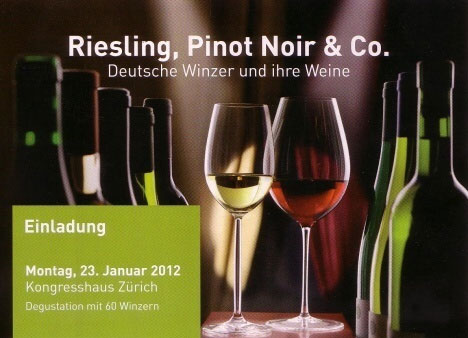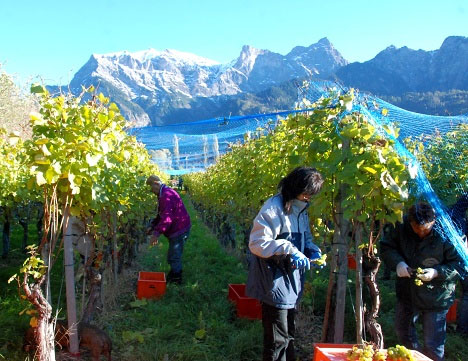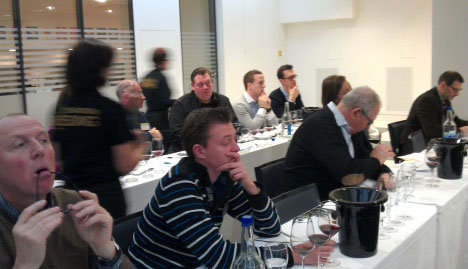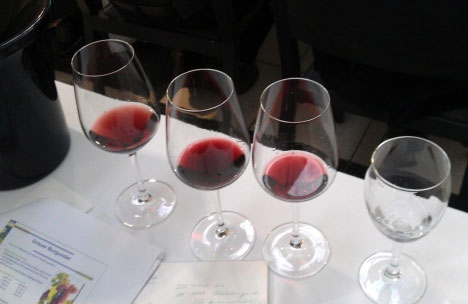Of course, there were more than two; there were about 60 or even 80 of them, winegrowers who presented their wines in Zurich, first and foremost their Rieslings. They can be proud of that and they also know that there is nothing comparable in Switzerland, at least not Rieslings of this variety and quality. Here, Chasselas (from western Switzerland) dominates. It largely determines the idea of what a white wine should be like. Rieslings are strangers here, especially since Müller-Thurgau dominates the white grape varieties in eastern Switzerland.

|
| Invitation of the German Wine Institute (Source: P. Züllig) |
However, this statement is highly simplified. In the meantime, there are a few wine merchants who also focus on German Rieslings, and they say: business is getting better and better. Maybe it's because the Swiss (especially in German-speaking Switzerland) are gradually discovering Rieslings, from dry to "lieblich" to sweet, and like them. Wouldn't be bad at all, not only for the German winemakers who find a new sales area here - in the neighbourhood - but also for the Swiss who are still looking for a home in white wine. At least that's how it seems to me. Besides Chasselas and Müller-Thurgau, pretty much everything is planted and vinified, from Pinot Blanc and Pinot Gris to Chardonnay and Gewürztraminer to the many autochthonous and interspecific grape varieties.

|
| Harvesting white grapes in Eastern Switzerland - actually a Pinot Noir region (Source: P. Züllig) |
In the meantime, I too have got used to some of the "names" of German wine - namely as offered by "my" wine merchant (one of the best for German wines in Switzerland): Brennfleck, Christmann, Christoffel, Diel, Dr. Loosen, Dönnhoff, Grans-Fassian, Haag, Jung, Keller, Kühn, Maximin Grünhäuser, Müller, Prüm, Schäfer, Schloss Lieser, Schloss Saarstein, Vollenweider, von Winning, Weil, Weiser-Künstler, Wittmann, Zilliken (in alphabetical order!). I'm looking for one or the other of these names at the German wine fair in Zurich: They should be represented - I think, and many of the wine lovers who are interested in German wines are thinking the same thing. No such luck! Not one of these wineries is to be found here. Slightly frustrated and somewhat helpless, I wander through the rows of tasting tables and meet a wine lover who actually likes French wines. He comes from Burgundy, but has lived in Switzerland for a long time. "You're here?" The last place I would have expected to see him is at a German wine presentation. Judging by his blue-stained lips, he's been mostly into red wines, especially the Pinot Noirs. He recognises my disgruntled mood. "Frustrated?" - "More like perplexed!" True, I have already visited one or two winemakers (especially from Baden) - I know their wines. "And now what?"

|
| More than 60 vintners present their wines in Zurich (Source: P. Züllig) |
Then he points to two tables with two young winemakers on the other side of the hall, almost at the edge. "You have to go there!" and he disappears with his tasting glass in his hand, Pinot Noir is probably in it. I immediately went to the two young winemakers, tasted their wines extensively, of course the reds first, I know my way around Pinot Noirs, Rieslings are still a "book with seven seals" from time to time. My mood is noticeably better, finally I've dropped an anchor with German wines. Almost by chance, or because of a tip from a Frenchman. The wines are still young, some of them still barrel samples. But I like them. I am aware that they could also be other wines, at another table. A direct comparison is difficult. Where should I start, where should I stop, what should I taste? What I already know or something new? But where is the new, at wine presentations of eighty winemakers?

|
| Where is the new% the unknown? Wine lovers seek orientation in the seminar on offer (Source: P. Züllig) |
I know I am being unfair to all those producers I could not visit in this short time. Perhaps it is even wrong for me to have narrowed down the German wine world for an hour (or more) to two winemakers. Both come from the Palatinate. Coincidence, of course. Both present - in addition to very good, even excellent Pinot Noirs - interesting cuvées, two wines with a high proportion of a grape variety that is virtually unknown in Switzerland: St. Laurent. My first reaction: needs getting used to; then: interesting; a little later (after repeated tasting): great potential; and finally: excellent. I must remember these winemakers, because in the meantime I have also tasted their other wines, even the Rieslings, which suddenly struck me as much, much better than all the Rieslings I had tasted before. Where is my objectivity, where is my analytical judgement, of which I am so proud? Without a doubt: these are excellent wines from Germany, perhaps not quite typical, perhaps a little idiosyncratic, a few decisive nuances different. It was precisely this that pleased me, that reconciled me with all the other winemakers with whom I was not at the table or did not last as long.

|
| In desperate search of the typical German wine (Source: P. Züllig) |
The afternoon is "saved", the wine world (including the German one) is back in order. Perhaps a chance hit, but important for me, so that from now on I don't simply reduce German wines to names and grape varieties, but am always aware that even with a parade of 60 and more suppliers, the wines are always diverse, independent and actually something quite personal. The quality assessment is only one side, the personal taste the other, perhaps even the more important.
Sincerely
Yours
Peter (Züllig)
PS: It would be unfair not to mention the two wineries that "saved" my encounter with German wines. They are: Ralf Kirchner in Freinsheim and Thorsten Langenwalter in Weisenheim am Sand.